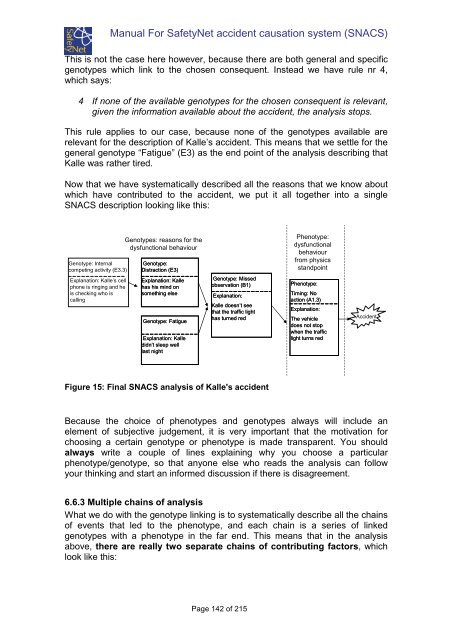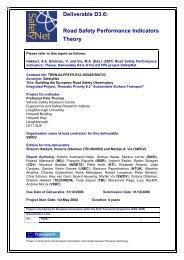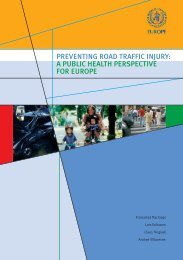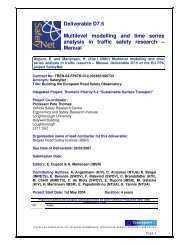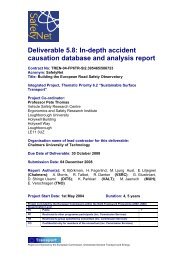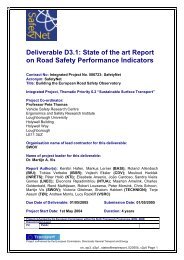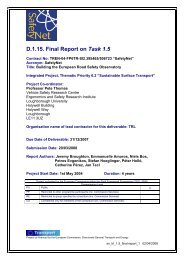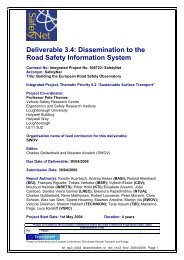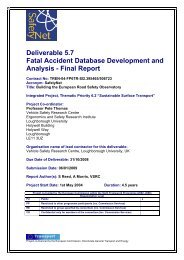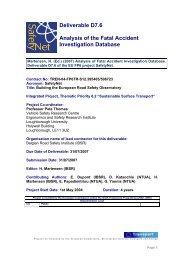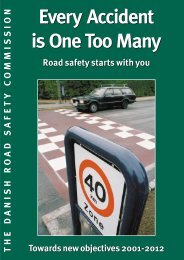Glossary of Data Variables for Fatal and accident causation ... - ERSO
Glossary of Data Variables for Fatal and accident causation ... - ERSO
Glossary of Data Variables for Fatal and accident causation ... - ERSO
Create successful ePaper yourself
Turn your PDF publications into a flip-book with our unique Google optimized e-Paper software.
Manual For SafetyNet <strong>accident</strong> <strong>causation</strong> system (SNACS)<br />
This is not the case here however, because there are both general <strong>and</strong> specific<br />
genotypes which link to the chosen consequent. Instead we have rule nr 4,<br />
which says:<br />
4 If none <strong>of</strong> the available genotypes <strong>for</strong> the chosen consequent is relevant,<br />
given the in<strong>for</strong>mation available about the <strong>accident</strong>, the analysis stops.<br />
This rule applies to our case, because none <strong>of</strong> the genotypes available are<br />
relevant <strong>for</strong> the description <strong>of</strong> Kalle’s <strong>accident</strong>. This means that we settle <strong>for</strong> the<br />
general genotype “Fatigue” (E3) as the end point <strong>of</strong> the analysis describing that<br />
Kalle was rather tired.<br />
Now that we have systematically described all the reasons that we know about<br />
which have contributed to the <strong>accident</strong>, we put it all together into a single<br />
SNACS description looking like this:<br />
Genotype: Internal<br />
competing activity (E3.3)<br />
Explanation: Kalle’s cell<br />
phone is ringing <strong>and</strong> he<br />
is checking who is<br />
calling<br />
Genotypes: reasons <strong>for</strong> the<br />
dysfunctional behaviour<br />
Genotype:<br />
Distraction (E3)<br />
Explanation: Kalle<br />
has his mind on<br />
something else<br />
Genotype: Fatigue<br />
Explanation: Kalle<br />
didn’t sleep well<br />
last night<br />
Genotype: Missed<br />
observation (B1)<br />
Explanation:<br />
Kalle doesn’t see<br />
that the traffic light<br />
has turned red<br />
Phenotype:<br />
dysfunctional<br />
behaviour<br />
from physics<br />
st<strong>and</strong>point<br />
Phenotype:<br />
Timing: No<br />
action (A1.3)<br />
Explanation:<br />
The vehicle<br />
does not stop<br />
when the traffic<br />
light turns red<br />
Accident<br />
Figure 15: Final SNACS analysis <strong>of</strong> Kalle's <strong>accident</strong><br />
Because the choice <strong>of</strong> phenotypes <strong>and</strong> genotypes always will include an<br />
element <strong>of</strong> subjective judgement, it is very important that the motivation <strong>for</strong><br />
choosing a certain genotype or phenotype is made transparent. You should<br />
always write a couple <strong>of</strong> lines explaining why you choose a particular<br />
phenotype/genotype, so that anyone else who reads the analysis can follow<br />
your thinking <strong>and</strong> start an in<strong>for</strong>med discussion if there is disagreement.<br />
6.6.3 Multiple chains <strong>of</strong> analysis<br />
What we do with the genotype linking is to systematically describe all the chains<br />
<strong>of</strong> events that led to the phenotype, <strong>and</strong> each chain is a series <strong>of</strong> linked<br />
genotypes with a phenotype in the far end. This means that in the analysis<br />
above, there are really two separate chains <strong>of</strong> contributing factors, which<br />
look like this:<br />
Page 142 <strong>of</strong> 215


